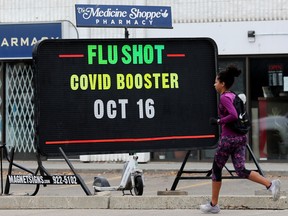
Article content
A forecasting device combining mathematics with artificial intelligence is predicting an earlier surge in flu and COVID-19 cases this year, according to researchers.
Researchers based at the Interdisciplinary Lab for Mathematical Ecology and Epidemiology (ILMEE) at the University of Alberta have devised a way to predict the transmission rate of infectious diseases.
Advertisement 2
Article content
According to the team’s calculations, confirmed flu cases in United States laboratories are expected to exceed 1,600 per day by the end of November, nearly double of what it was the same time last year, which was 955 cases per day. Canada is expected to emulate similar numbers.
Hao Wang, a professor and Tier 1 Canada Research Chair in mathematical biosciences at the University of Alberta, was part of the Canadian and U.S. team behind the new forecasting approach that was recently published in the Society of Industrial and Applied Mathematics Journal. He said the data they used came from hospitals and laboratories in the U.S. because there is limited data in Canada.
“Normally, we look at the U.S. data first as a priority, and I think that reflects the situation in Canada. These two countries are highly connected,” Wang said.
“According to our past experience working in both countries, the data sets use the same approach. They are… not absolutely synchronized but relatively synchronized compared to other countries.”
Noticeable surge in transmission by November
Wang said typically, December has the highest transmission rates, but according to the forecasting device, this year will be three to four weeks earlier. He said there will be a “hidden” increase by the end of October, which will indicate a noticeable rise, but in November, be prepared for a surge in transmission rates.
Article content
Advertisement 3
Article content
“If we know it’s three weeks or four weeks earlier this year, then flu vaccination should be taken earlier and we can educate the public to do so,” Wang said.
According to the study, the risk of flu infection was highest in December from 2013 to 2018, which indicates protection measures against the flu are worth taking as early as August each year in the U.S. and, by extension, Canada.
Despite observing higher peak flu infection in late 2022, Wang said by incorporating historical U.S. hospital flu data into their model, they estimated that while fatality rates increased during the COVID-19 pandemic, they have remained relatively stable when compared to pre- and post-pandemic periods.

How it works
The forecasting device works by using an inverse-based method to extract information from available pandemic and epidemic data to estimate transmission rates. Wang and his team used data from late 2015 to September 2024 in their model to generate a projected transmission number.
Wang said that combining the transmission data from the forecasting device with machine learning enables computers to learn from data and make decisions or predictions without being explicitly programmed to. It could forecast future disease dynamics based on factors like weather conditions, non-pharmaceutical intervention, and data collected from cellphones to help guide public health officials.
Advertisement 4
Article content
More data, more accuracy
Wang said while upper levels of government can provide infection and death data, that alone does not provide a complete picture of understanding accurate transmission patterns and planning for them. He said the data they currently have is seasonal and relevant for when peak transmission occurs, but being provided with updated data will help the forecasting device’s accuracy.
In his publication, Wang said data scarcity is a typical problem for newly emerging infectious diseases — especially at the initial stage of an epidemic or pandemic.
The actual number of infections may be underestimated if infected people are not diagnosed due to unawareness of symptoms or underdeveloped tracking and testing systems.
Effective data collection and surveillance must be harnessed, specifically in disadvantaged regions, the study said. When data from various areas such as those quarantined or hospitalized are available, this may be able to provide a more accurate estimate of transmission rates.
Recommended from Editorial
Bookmark our website and support our journalism: Don’t miss the news you need to know — add EdmontonJournal.com and EdmontonSun.com to your bookmarks and sign up for our newsletters.
You can also support our journalism by becoming a digital subscriber. Subscribers gain unlimited access to The Edmonton Journal, Edmonton Sun, National Post and 13 other Canadian news sites. The Edmonton Journal | The Edmonton Sun
Article content



